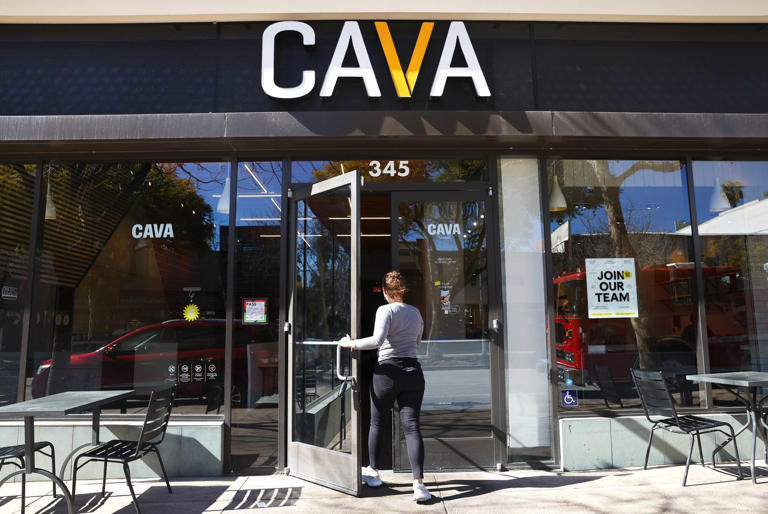At least one restaurant chain plans to hold the line on what it charges customers even as others are raising prices in California because of the state’s minimum-wage boost for fast-food workers.
Mediterranean-style restaurant chain Cava says its recent growth will allow it to absorb the higher labor costs without lifting menu prices. And with a smaller footprint in California than other chains that have said they would raise prices, Cava may not feel as much pain from higher labor costs. Keeping prices where they are for menu items like falafel and harissa honey chicken is the right move for consumers who are increasingly fatigued by higher fast-food prices, the company’s finance chief said.
Cava expects a 30-basis-point impact to overall margins because of the change, Chief Financial Officer Tricia Tolivar said. “But being thoughtful and mindful around the consumer in California, we’re not planning to put that on their back,” she added. Cava’s recent growth and increased foot traffic means the company can keep prices where they are. “We’re going to absorb that in the business overall and evaluate it ongoing,” Tolivar said.
Cava’s labor costs will increase this year because of the law setting the minimum wage for California fast-food workers at $20 an hour in April, a 25% increase from the state’s broader $16 minimum wage. Restaurant chains from Chipotle Mexican Grill to McDonald’s, Jack in the Box, and Shake Shack are planning to lift prices in the state in response to the change.
Analysts estimate the law in California, where roughly 7% of Cava’s 309 restaurants are located, will mean raising Cava’s wages in the state by around 17%.
In 2022, California passed a law putting oversight of the fast-food industry in the hands of state-appointed councils that could have raised pay to as much as $22 an hour. The restaurant industry allocated tens of millions of dollars to invalidating the law before a compromise was reached that set the new $20 minimum wage.
Total labor costs are already among the top line items for many restaurants, typically about 30% of sales with hourly labor making up most of that, said Brian Vaccaro, a senior restaurant analyst at Raymond James & Associates. “For a lot of restaurants, hourly labor can be 20%, give or take, of your cost structure as a percentage of sales,” he said. “When that’s going up, there aren’t many options but to raise prices as a result.”
For those increasing prices, the higher checks will come as the cost of eating out has already been running high. Prices for food eaten away from home were up 5.1% in January compared with a year earlier and up 30% from the same month in 2019, Labor Department data showed. Consumers in response are going out less often or ordering less. In some cases, they are pushing back on social media against potential price increases.
Cava raised menu prices nationwide around 3% in January in an effort to offset ingredient inflation. But with consumers’ wallets already stretched, further increases aren’t planned this year to offset the soon-to-be higher costs of labor in California, according to CFO Tolivar.
The Washington-based company’s revenue for Cava surged by more than 52% compared with a year earlier to $175.5 million for the quarter ended Dec. 31, boosted by the opening of 72 new Cava restaurants in fiscal year 2023. Same-store sales, or sales from stores in operation for at least a year, were up more than 11%, with more than half of that growth coming from higher traffic. The company is guiding for 3% to 5% same-store sales growth in 2024 and plans to open 48 to 52 new locations.
“Growth in restaurants and top-line performance will create other leverage opportunities to help offset some of that,” Tolivar said, referring to increased labor costs in California.
Cava’s footprint in California, at around 7% of total locations, is smaller than other restaurant chains, analysts said. About 43% of Jack in the Box’s 2,200 restaurants are located in California, while at least 11% of Shake Shack’s U.S. restaurants are located in the state, The Wall Street Journal reported last month. For Chipotle, around 15% of the burrito chain’s restaurants are in California.
The smaller presence in the state makes the wage increases an easier shock for Cava to absorb, said Andrew Charles, a senior restaurant analyst at TD Cowen. “They are looking at fast casual peers that have way greater penetration in California, and the one thing they don’t want to do is to risk their value proposition by being too expensive as they scale,” he said. “Margins are good, so they don’t need to take price to offset that.”
Cava may also see more customers with holding prices, analysts said. The average per person check at Cava is between $13 and $14. That’s generally on par with or below that of most direct competitors, according to Raymond James research. If Cava’s menu pricing remains where it is while others are getting pricier, diners may recognize that, Vaccaro said.
“I could see them saying, ‘Well, let’s see how the consumer responds to our competitors,’” he said of Cava. “In the meantime, it’s an investment in value.”
